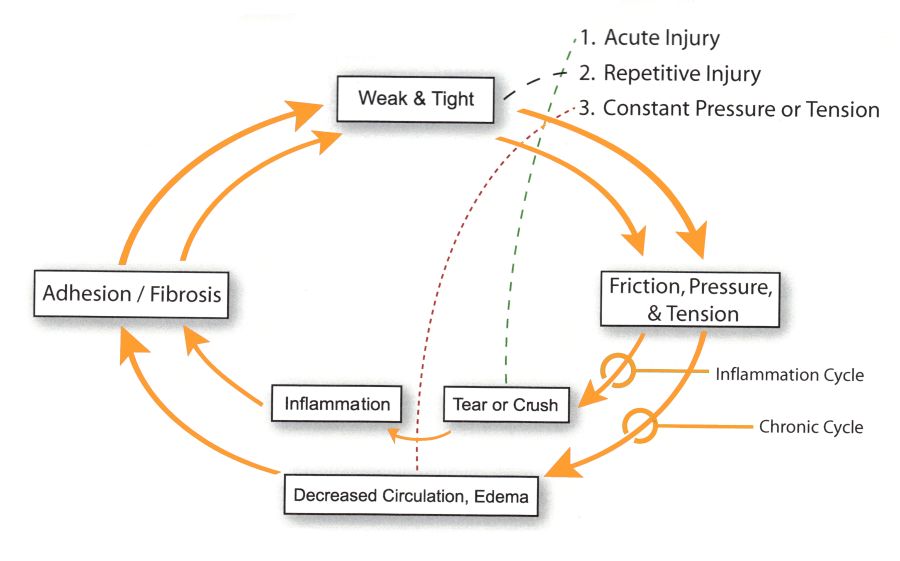Our brain controls our posture and our muscles. Therefore posture and muscle tone (i.e. how tight or relaxed a muscle is) is an expression of the brain. We must pay attention to this expression and how it relates to movement.
A frequent cause of disturbance in our movement quality, why muscles get tight, why we display poor posture, and why we may have trigger points or pain is due to insufficient muscular stabilization of our spine.
Insufficiency is our stabilization system is exactly the reason why patients and athletes who have poor body awareness demonstrate poor ability to simply relaxation. Believe it or not, relaxation is easier said than done. If the brain doesn't know how to relax fully certain muscles, the low-grade state of contraction will keep muscles and surrounding joints under constant stress. This constant stress will ultimately lead to trigger points in muscles, dysfunctional movement patterns, and altered posture.
This is why specific exercise progressions that respect the developmental aspects of posture and movement are so critical. Exercise should not only address muscle function, but it must also address brain control to change how our body functions.
"Brain Education" focuses on the efficiency of our postural and movement control to avoid overloading of specific tissues and joints while promoting muscular balance.
Movement and relaxation is a skill. It must be practice daily through purposeful exercise with complete awareness to the feeling of the movement. This is the gateway to change in the body. These changes are valuable to anyone who is simply looking to get out of pain or improve their athletic ability.
However, there are still those that challenge the notion that there is an “ideal” or “good” posture. They will have you believe that there is no such thing as “good” or “bad” posture. The reality is, when it comes down to determining what is “good” or “bad” posture can be simply summed up by saying….”It depends.”
What will dictate “good” or “bad” when it comes to form or posture will depend upon a number of variables specific to the individual. We can find efficient form and ideal posture that someone should respect and when they don’t, the result is excessive wear and tear on their joints and tissues, leading to pain and progression of degenerative changes.
Yes we need to be efficient in movement and have a vast movement capacity. Yes there is no single posture that we should maintain for an extended period of time, no matter how “good” it is.
But those notions go out the window when our body meets increasing external resistance to our movement or we are performing movement at increasing speeds.
What does that mean?
Yes, we should be able to flex our spines and perform a body weight squat with posterior pelvic tilt (aka the dreaded “butt wink”) and resultant lumbar spine flexion. Yes this would be considered normal healthy human motion. But that doesn’t mean that one should perform a loaded barbell squat with the same intent or form. This could be an injury waiting to happen. When increased load or speed of movement comes into the picture (ex. barbell squat), very specific considerations must be made to that individual on the form and posture they express during the squat pattern to maximize their muscular efficiency and minimize stress placed on the joints.
These are the same considerations that must be respected when it comes to rehab and the subsequent development of fitness/physical ability. According to McGill, this breaks down into two stages:
- Stabilization of the injury and reduction of pain by approaches that follow desensitization and healing.
- Development of strength and physical ability only begins when the first stage has been achieved.
Once pain is reduced, the development of specific fitness qualities can take center stage. This is when we address the complexity of the movement system. Panjabi established the importance of the passive, active, and neural systems for trunk/core stability and movement. Jull and Richardson found in voluntary movement, activity of the deep spinal muscles precedes activations of the superficial muscles (aka feed forward mechanism).
The integrated spinal stabilization system (ISSS) serves as the “feed forward stabilization mechanism”. The ISSS consists of the diaphragm, pelvic floor, all parts of the abdominal wall, short intersegmental spinal muscles, deep neck flexors, and serratus anterior. We know that these muscles essentially form the “deep core” that is so important to train for efficiency of posture and movement.
The ISSS required “Brain Education” to work optimally. There is no way around it. We must focus our attention and efforts to ensuring that no matter the task, we must rely of the ISSS if we are going to realize our movement potential, maintain healthy posture, and minimize joint pain.
Don’t fall into the trap of believing someone who says “good” or “bad” posture doesn’t exist. Again the answer is it all depends. Posture and the considerations we make regarding it are always specific to the individual and task at hand. Posture shouldn’t handled in a general approach. Most rehab, training programs and online instruction is handled in an over-generalized fashion. When people need specific, when they need individualized considerations. And that’s the best approach when it comes to helping one learn how to educate their body in regards to what’s best for their posture and movement.
For more related reading:
https://gallagherperformance.com/movement-that-enhances-performance-reduces-injury/
https://gallagherperformance.com/a-movement-screen-will-never-show-movement-habits/
https://gallagherperformance.com/low_back_pain_causes_and_treatment_recommendations/
https://gallagherperformance.com/chiropractic-rehab-dns-treatment/
https://gallagherperformance.com/a-solution-to-headaches/
https://gallagherperformance.com/finding-a-solution-to-your-shoulder-pain/

